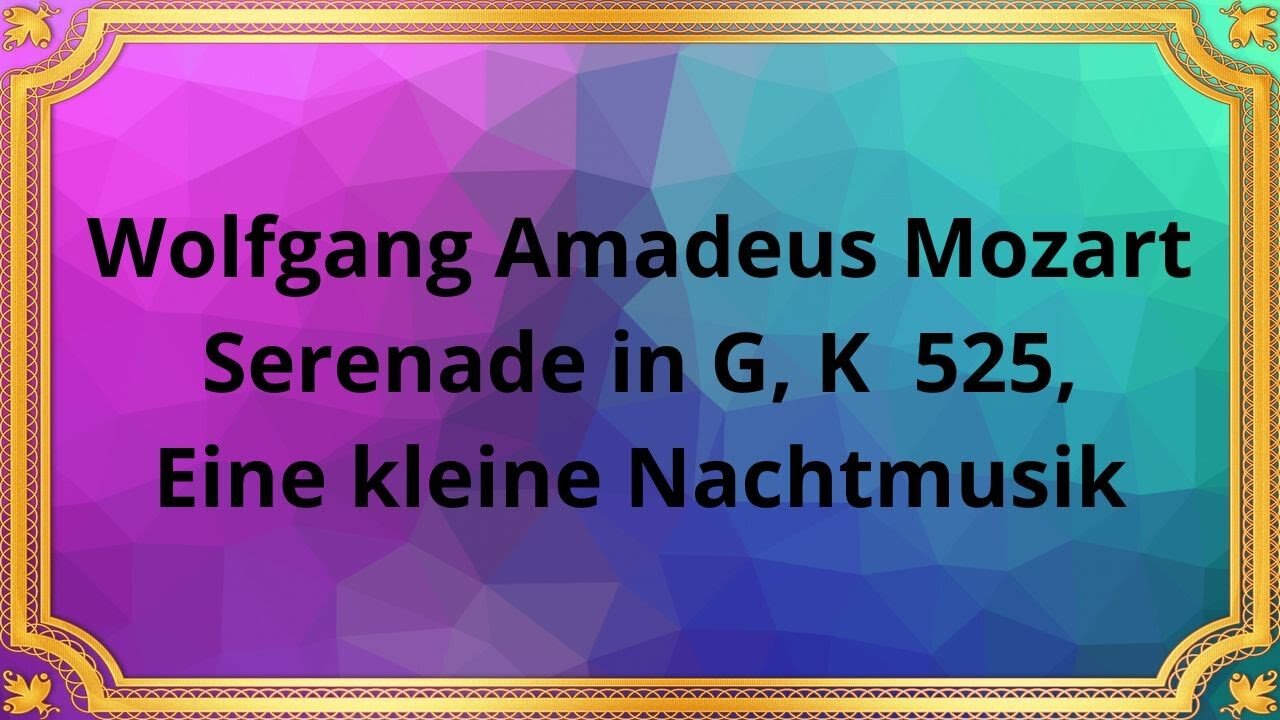Premium Only Content

Wolfgang Amadeus Mozart Serenade in G, K 525, Eine kleine Nachtmusik
#Mozart #ClassicalMusic #SerenadeinG #EinekleineNachtmusik #MusicalComposition #MusicHistory #ClassicalComposers #OrchestralMusic #Symphony #MusicAppreciation
Publication date 1939
London Symphony Orchestra conduted by Felix Weingartner
Wolfgang Amadeus Mozart, one of the most influential composers in history, gifted the world with his remarkable Serenade in G, K 525, commonly known as "Eine kleine Nachtmusik." This iconic piece of classical music has captivated audiences for centuries with its elegance, grace, and timeless beauty.
Mozart composed "Eine kleine Nachtmusik" in 1787, during what is known as his "golden years." It is believed to have been written for a string ensemble, consisting of two violins, a viola, cello, and double bass. The serenade is comprised of four movements: Allegro, Romanze, Menuetto, and Rondo. The entire composition exudes Mozart's signature style, showcasing his mastery of melody, harmony, and form.
The first movement, Allegro, opens with a lively and energetic melody that immediately captures the listener's attention. The soaring violin lines, supported by the rich harmonies of the accompanying instruments, create a sense of joy and exuberance. This movement is a perfect example of Mozart's ability to infuse his compositions with both complexity and accessibility.
The second movement, Romanze, offers a stark contrast to the preceding Allegro. It is a serene and introspective piece, characterized by its lyrical melodies and delicate ornamentation. The violin takes on a more expressive role, weaving a tapestry of emotions that evokes a sense of tranquility and introspection.
The third movement, Menuetto, introduces a lively dance-like rhythm, reminiscent of a traditional minuet. This movement showcases Mozart's ability to blend elegance with playfulness, as the instruments engage in a spirited dialogue, trading melodic motifs and creating a joyful atmosphere.
The final movement, Rondo, brings the serenade to a triumphant close. It is a lively and spirited piece, characterized by its catchy and memorable themes. Mozart skillfully weaves together various musical ideas, building anticipation and creating a sense of exhilaration as the music reaches its climactic conclusion.
"Eine kleine Nachtmusik" stands as a testament to Mozart's genius and mastery of musical composition. Its enduring popularity can be attributed to its combination of technical brilliance, emotional depth, and sheer beauty. The serenade has been performed in countless concert halls and has been featured in various forms of media, solidifying its place as one of the most recognizable pieces of classical music.
Conclusion:
Wolfgang Amadeus Mozart's Serenade in G, K 525, "Eine kleine Nachtmusik," remains a cherished masterpiece that continues to captivate listeners of all generations. Its timeless beauty, intricate composition, and emotional resonance ensure that it will forever be regarded as one of the greatest musical works in history. Through this serenade, Mozart's genius shines brightly, reminding us of the profound impact that his music continues to have on the world of classical music.
You have the opportunity to support the channel https://destream.net/live/RadSiarAl/donate
You have the opportunity to support the channel
https://www.donationalerts.com/r/radsiaral
-
 1:08:16
1:08:16
Tactical Advisor
5 hours agoNEW Budget Glocks | Vault Room Live Stream 011
34.7K3 -
 16:30
16:30
SNEAKO
12 hours agoNO FRIENDS IN THE INDUSTRY.
76.5K17 -
 6:19
6:19
BlackDiamondGunsandGear
1 day agoHow Fat Guys can Appendix Carry
48.5K3 -
 6:58
6:58
Gun Owners Of America
1 day ago2024 Was Huge For Gun Rights, Here's Our Top 10 Wins!
42.6K1 -
 15:50
15:50
Degenerate Jay
1 day ago $1.73 earnedJames Bond Is Being Ruined By Amazon? Make Him A Black Gay Woman?
31.7K9 -
 15:18
15:18
DeVory Darkins
1 day ago $15.01 earnedTrump Drops NIGHTMARE Warning on Joe Biden
47.1K79 -
 36:13
36:13
The Why Files
1 month agoAlien Implants Vol. 1: Devil’s Den UFO Encounter: What Was Found Inside Terry Lovelace?
75.1K40 -
 9:03
9:03
Alabama Arsenal
1 day ago $0.62 earnedAAC HUB 2K | Modern Features, Iconic Classic Looks
15K1 -
 13:49
13:49
Dermatologist Dr. Dustin Portela
2 days ago $0.87 earnedDermatologist Reveals the Worst Things To Do To Your Skin
12.6K2 -
 1:02:24
1:02:24
PMG
1 day ago $0.37 earned"Hannah Faulkner and Jamie Villamor | DEFEND, INSPIRE, INFLUENCE"
10.1K